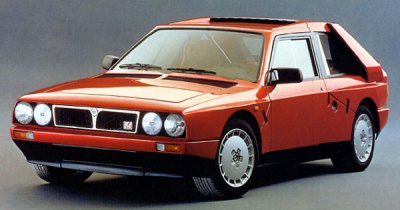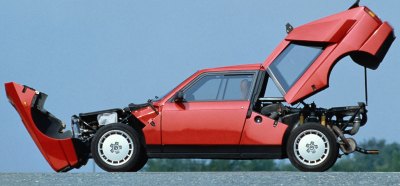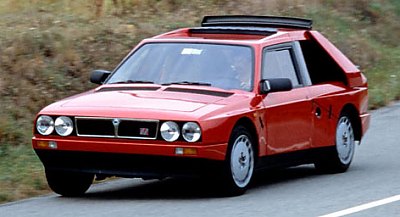 The S4 succeeded 037 on the stage of world rallying. Its predecessor won the world championship in 1983, which was also the last time won by a rear-drive machine. By season 1984, it was obvious that 4WD cars like Audi Sport Quattro and Peugeot 205T16 started dominating the races. Lancia therefore decided to develop a 4WD car from scratch. The 4WD system of Delta S4 comprised of a Ferguson transfer case splitting torque 30:70 front to rear and a limited slip viscous coupling. It's not as advanced as Peugeot's variable torque split, but the Lancia's chassis was better balanced, thanks to the longitudinal installation of its powertrain. The transmission and center differential were located fore of the longitudinal engine.  Another problem of the outgoing 037 was lack of power. Even in ultimate form its supercharged engine mustered only 325 horsepower. The S4 produced 470hp from the outset. Its engine was downsized to 1759cc (to slip into the 900kg class), but it was boosted by the most advanced forced induction system of the time – a mechanical supercharger plus a turbocharger ! It was the world's first of its kind. Contemporary turbochargers were not as efficient as today's. They provided no boost at low rpm and a great deal of turbo lag, which affected drivability. For a rally car, a flat torque curve over a wide range of rpm is always crucial, since it has to accelerate out of corner from very low speed to near top speed in 10 seconds. A mechanical supercharger could complement the black hole at the low-end power delivery and resulted in a flat torque curve. Nevertheless, a supercharger is always power consuming, the worse the higher the rev. Therefore Lancia designed the system such that once the turbo got running, a bypass valve relieved the pressure from the supercharger so that the latter was deactivated. The theory seemed simple, but it took Lancia and Abarth a lot of research to smoothen the transition between supercharger and turbocharger.  The chassis of S4 was tubular steel space frame reinforced by box section structure. Suspensions were double-wishbones all-round, with twin-shock absorbers at each rear wheel. The bodyshell was made of lightweight glass-fiber and epoxy resin (carbon-fiber and Kevlar in race car). It wasn't really styled, looking more like a military vehicle (with a bit Lamborghini LM002). Large scoops at C-pillars and on the roof draw air towards the intercoolers (one for supercharger and one for turbocharger) without much consideration for aerodynamics. The cheap horizontal sliding door windows were nonsense for its price. However, the 2-seat interior was reasonably well finished.  The homologation road cars didn't come close to the race car in terms of power, of course, but they still possessed 250 horsepower, or a remarkable 142 hp per liter. Performance was claimed to be 140 mph flat out and 0-62 mph acceleration taking 6.0 seconds. Like other Group B rally specials, people bought it for A-to-B rather than straight line performance. If you compare it with Ferrari 328GTB, you will find it much slower in straight line, but could easily destroy the Ferrari on mountain roads. In WRC, Delta S4 experienced a tragic fate. It won its debut race in 1985 RAC rally, then dominated the 1986 season until leading driver Henri Toivonen crashed in Tour de Corse (Corsica Rally), killing himself and navigator Sergio Cresto. The team lost momentum and eventually handed the championship title to Peugeot. This accident led to the rethink of Group B, which was considered too powerful to be safe, and eventually its demise after that season. Delta S4 was generally believed to be the best rally car of its time, albeit an uncrowned one.  |